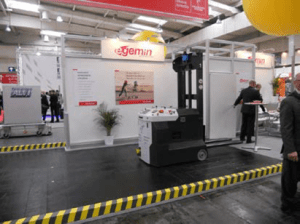The viability of autonomous mobility for the industrial market has been catalyzed by the success of Kiva Solutions and iRobot. The commercial success of autonomous mobile robotics from these companies has transformed the technology from a novelty and curiosity status to a technology to be taken seriously. While these companies garner considerable media attention, the use of autonomous mobility remains under the media radar in automatic guided vehicles (AGVs) and forklifts. AGV and forklift truck technology has largely undergone a transformation over the last 6 years in which many of the well-entrenched material handling companies have integrated more robust navigation systems into these mobile platforms. Labor costs, an increased spotlight on employee safety and ergonomics, and the desire for improved operational efficiency are major drivers for this progression.
 Mobile technology has been in use in the warehouse for many years, as forklift truck OEMs have incorporated navigational capabilities in these vehicles, but in some ways the navigation was limited. Today many of the well-entrenched material handling companies offer products using navigation technology with a more robust form of navigations with autonomous decision-making capabilities. This is a departure from older AGV solutions, which navigated on wires or guided tape physically affixed to the warehouse.
Mobile technology has been in use in the warehouse for many years, as forklift truck OEMs have incorporated navigational capabilities in these vehicles, but in some ways the navigation was limited. Today many of the well-entrenched material handling companies offer products using navigation technology with a more robust form of navigations with autonomous decision-making capabilities. This is a departure from older AGV solutions, which navigated on wires or guided tape physically affixed to the warehouse.
While wire-guided AGVs have been utilized for decades, autonomous AGVs and forklifts using laser scanning and other sensing methods are providing more flexibility without the associated cost of infrastructure changes. Additional technology trends include the transformation from simple environmentally-aware vehicles primarily used for transportation from point A to point B, to vehicles which come bundled with much more sophisticated software design, including warehouse organization, pallet building, etc.
The next step for this market is natural feature recognition, which will be the next evolution in autonomous vehicle mobility. The use of low cost camera technology could lead to the demise of laser-based guidance. Laser-based systems have relied upon placing of reflective tape in key locations in the facility to enable the autonomous vehicle to determine its coordinates; camera technology will instead utilize object recognition in the facility for guidance purposes.
Often the hurdle with an emerging technology is ensuring that there is a ROI for a large capital investment. Fully-autonomous forklifts do not require any obtrusive infrastructure around them and this makes investments in this technology more scalable – i.e. you can start small and add new equipment as needed.
Obviously, automation is frequently put in place to reduce labor costs. But the safety benefits of this technology are often overlooked. There are approximately one million forklifts in the United States alone, with around twice as many operators. These one million forklifts are involved in 110,000 accidents per year causing 94,750 injuries, according to statistics from the Occupational Safety and Health Administration (OSHA). In fact, one in six workplace fatalities involve forklifts in some capacity. Though many of these accidents could be prevented through more thorough safety measures, safety is a driver for automation in the warehouse. Many companies have started to transition away from traditional forklifts, instead adding automation to their forklifts.
Tasks such as loading and unloading forklifts, moving around inventory, etc. can cause a wide range of injuries to warehouse or factory workers. By automating these tasks with mobile robots, the factory or warehouse becomes a safer place for employees.
Scott Evans is an Analyst at the ARC Advisory Group. Scott’s focus areas include Additive Manufacturing/3D Printing, 3D Laser Scanning, Machine Vision, and Autonomous Mobile Robotics. He is also a member of ARC’s Internet of Things (IoT) team.
















